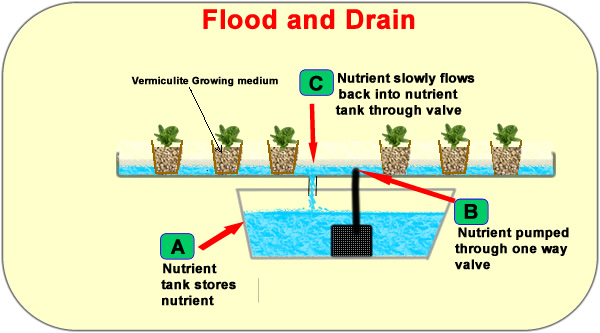There are a variety of different designs for hydroponic systems.
Popular systems include:

In a simple NFT hydroponic system the nutrient is stored in a tank (A) and then pumped along narrow tube by a submerged flow pump (B). The systems is sized to deliver typically 2-3 litres per minute of nutrient 24 hours per day into the growing channel (C). This creates a thin film of nutrient along the bottom of the angled grow channel which can then be absorbed by the plant roots. Excess nutrient is then collected and returned to the nutrient tank (E).
NFT relies on a continuously running pump to deliver a low but continuous flow of nutrient over the plant roots. The pump used must be designed for continuous operation.
As with all re-circulating systems, the nutrient concentration will fall over time as the plants absorb the dissolved minerals. The Electrical Conductivity (EC) of the solution will need to be maintained by adding additional nutrients and the whole solution will also need to be changed periodically.
To prevent disease it can be advisable to filter the returning solution and expose it to UV light before returning it to the nutrient tank. On a hobbyist system this can be achieved using readily available pond filters.
Hydroponic Drip Systems – Rockwool growing medium

Drip systems use a nutrient tank (A) and a timer contolled flow pump (B). Typically once an hour the pump will be switched on for 1-3 minutes depending on the plant nutrient requirements. Nutrient is pumped into a transport pipe. Depending on the system 13mm, 19mm or 25mm pipe can be used. At each plant position this pipe is tapped into by a dripper which allows water to flow though at a limited rate (generally between 2 and 9 litres an hour) to a 4mm delivery pipe (C).
The delivery pipe has a drip stake at the end of it which drips nutrient onto the grow medium (D). The irrigation cycle is set on the pump so that the grow medium receives more than enough nutrient to saturate the slab with excess nutrient draining back down to the nutrient tank (E).
It is important that at least 20% more nutrient is delivered than required to allow any excess build up of salts in the grow medium to be flushed back into the nutrient tank. When using Rockwool slabs as a grow medium, the slabs are generally covered in white polythene to ensure that no roots are exposed in the open topped channel. To prevent the slabs from getting waterlogged, 25mm cuts are made in the polythene between the plants. This allows excess nutrient to drain away. For more information see Growing Media.
Drip systems differ from NFT hydroponic systems described above in a few key areas:
- An inert growing medium, such as Rockwool, Perlite or Vermiculite is used to retain nutrient around the plant roots
- The grow medium needs to be fully saturated with nutrient and allowed to stand for 24 hours before plants are introduced into the system.
- The nutrient pump is operated on a cyclical basis, normally providing a stream of nutrient for maybe two minutes per hour
- The nutrient is delivered to the top of the growing medium and then filters down towards the plant roots
Flood and Drain (Ebb and flow)

In a flood and drain system, nutrient is pumped from the nutrient tank (A) into a a grow tray using a pump (B). A one way valve allows the nutrient to flow into the grow tray only, flooding the roots of the plants. The nutrient then gradually flows back into the nutrient tank (C). The pump is operated in cycles using a timer.
The flood and drain system ensures that the roots get nutrient (when flooded) and then access to oxygen in the air (when the nutrient drains back into the tank). Plants are grown in porous containers filled with a growing medium such as Vermiculite / Perlite or can also be grown in 7.5cm Rockwool cubes. This ensures the plant roots always have access to nutrient.
In a water culture the plant roots are immersed in water, with the plant itself floating on a raft with a hole in. View the video below to see commercial water culture in operation.
Your industry is listed with a ROBO WINDER a hose reel with an aquatic motor. Can it still be purchased? KFM
Hi Ken
See http://www.hydro-industries.com/hose-reels/ for details.
I am a retired Market Gardener and I used to grow tomatoes and peppers in a fairly large NFT unit in which I could automatically control PH (very important in hard water conditions like mine) . As a hobby I am considering setting up a small system in a greenhouse measuring 30 ft by 15 ft so I am looking for a system which will automatically control PH in a circulating system since monitoring manually is too laborious in a greenhouse at some distance from my house. What I should need is a ph meter with max and min connections to a small valve allowing a drip feed of dilute nitric acid. Somewhat difficult I assume, but I should appreciate any help you could give me in this matter. Thanks
Ardiuno based systems for pH monitoring are out there and can easily be set to turn a pump on or off. with a little finagling you could have it add a few drops of pH up or down as needed based on an hourly/daily sample.